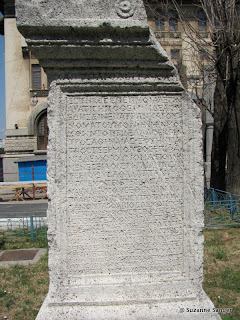We recently returned from a trip to Eastern Europe. We toured with Vantage, and visited five former Soviet Bloc countries (Romania, Bulgaria, Serbia, Croatia, and Hungary), mostly via riverboat. I'll share some photos over the next several days.
For starters, here we are in Transylvania, Romania. This is Sinaia, Romania, a charming resort town.
We walked a little way up the hill from the town square and found some wonderful rooftops.

This is our hotel, in Brasov, Romania. This was a four star hotel with an old and a new wing. We were in the new one, nicely appointed rooms, the usual nine yards. But every single member of our 40-person group reported that their shower leaked all over the floor. Since we were there for three nights, we had some time to try to figure out why. It was not the smallish half-tub-length glass door they used instead of a curtain. There was not a single drop of water on the edge or side of the tub. I'm pretty sure the flood was coming from somewhere back in the wall--a bad connection, perhaps. In fact, water even appeared on the floor when the sink was used. But in every room??? How is this possible? I don't know the answer to that, but I do know they'd better get a grip on this problem before rot and mildew turn the building to rubble. Which brings me to an interesting comparison. In the lawsuit happy US (and probably most western countries), I can't imagine this issue being neglected for long. Water turning tile floors into skating rinks sounds like a lawsuit waiting to happen to me. Over here, apparently not so much. One day at lunch a glass of wine was spilled all over a tile floor. The wait staff just ignored it. Again, wouldn't that be wiped up quickly elsewhere so a guest wouldn't slip and sue? I don't want this to sound like a complaint. We had a wonderful trip and these were honestly the only things I can think of that weren't pretty close to perfect. But it certainly did surprise me that neither seems to be seen as a potential problem.

And this tells us where we are. We stayed in Brasov for three nights, exploring castles and countryside during the day.
We really enjoyed our time in Brasov. Every evening we found ourselves in this relaxing pedestrianized area filled with shops and eateries. It was delightful to enjoy dinner on our own outdoors, eating great food and people watching. On Saturday night, we were even treated to two bridal parties cruising the square. One of them was having a reception in our hotel, but because these are pretty much all day events, beginning with a civil ceremony in the morning, then a church wedding, and then a reception that lasts well into the wee hours of the night with a parade of food and lots of dancing, the bridal couples and their friends often escape to enjoy the outdoors sometime in the early evening.
One thing we found unusual here was dealing with the money situation. At our first briefing, we were told that our credit cards might not work in Romania UNLESS we had a PIN number for them. What? Isn't that for a debit card? Turns out you CAN get a PIN number for a credit card if you ask, but who knew? So the first afternoon, John stopped in at TEN restaurants to see if they would take a credit card without a PIN. Seven of them said no. That night, we ended up eating at one of the three that would. Then we called the bank in the US and got a PIN number--which of course, we were never asked for. LOL. But it turns out they didn't ask because when they ran the card, they could tell we had one, which apparently is all they care about. Don't ask. I have NO idea why.
The next unusual thing we learned was that if you put a tip on your credit card, the tip money goes to the BANK and the waitress never sees it. WHAT??? We felt horrible when we learned that on the second night of our stay in Brasov because we had charged our tip the first night. We used cash for tipping the rest of the time. And speaking of cash, each of the five countries we visited has its own currency, and none of them work anywhere else. Euros and dollars MAY be accepted, but not always. Juggling money here is a challenge, for sure!










































